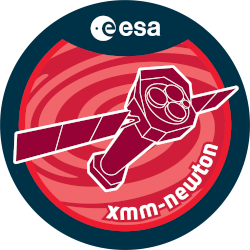

| Proposal ID | 086290 |
| Title | Red quasars: a special phase in the co-evolution of supermassive black holes? |
| Download Data Associated to the proposal | https://nxsa.esac.esa.int/nxsa-sl/servlet/data-action-aio?obsno=0862900201 |
| DOI | https://doi.org/10.57780/esa-sxjz08l |
| Principal Investigator, PI | Dr David Rosario |
| Abstract | From a systematic study of the radio properties of luminous red quasars in theSDSS, we have found clear evidence that distinguishes them from the more normalblue quasars, suggesting that they are a special stage in the co-evolution ofAGN. To complement an on-going VLT/XSHOOTER program exploring the differences inthe accretion disks of red quasars at z=1.5, we propose new XMM-Newtonobservations of 5 carefully selected targets, which, in combination with anarchival dataset of normal quasars, will allow a controlled study of differencesin (1) nuclear obscuring columns, (2) intrinsic X-ray to optical spectral slope,and (3) coronal properties. Our study is designed to uncover whether red quasarshave systematically different accretion disks from normal quasars. |
| Publications |
|
| Instrument | EMOS1, EMOS2, EPN, OM, RGS1, RGS2 |
| Temporal Coverage | 2021-02-20T21:31:36Z/2021-03-08T21:15:54Z |
| Version | 18.02_20200221_1200 |
| Mission Description | The European Space Agencys (ESA) X-ray Multi-Mirror Mission (XMM-Newton) was launched by an Ariane 504 on December 10th 1999. XMM-Newton is ESAs second cornerstone of the Horizon 2000 Science Programme. It carries 3 high throughput X-ray telescopes with an unprecedented effective area, and an optical monitor, the first flown on a X-ray observatory. The large collecting area and ability to make long uninterrupted exposures provide highly sensitive observations. Since Earths atmosphere blocks out all X-rays, only a telescope in space can detect and study celestial X-ray sources. The XMM-Newton mission is helping scientists to solve a number of cosmic mysteries, ranging from the enigmatic black holes to the origins of the Universe itself. Observing time on XMM-Newton is being made available to the scientific community, applying for observational periods on a competitive basis. |
| Creator Contact | https://www.cosmos.esa.int/web/xmm-newton/xmm-newton-helpdesk |
| Date Published | 2022-04-06T00:00:00Z |
| Last Update | 2025-01-27 |
| Keywords | "xmm newton", "xshooter program exploring", "normal blue quasars", "special stage", "optical spectral slope", "SDSS", "nuclear obscuring columns", "coronal properties", "co evolution", "red quasars \:", "XMM-Newton", "luminous red quasars", "radio properties", "red quasars", "archival dataset", "special phase", "XMM", "accretion dis", "normal quasars" |
| Publisher And Registrant | European Space Agency |
| Credit Guidelines | European Space Agency, Dr David Rosario, 2022, 'Red quasars: a special phase in the co-evolution of supermassive black holes?', 18.02_20200221_1200, European Space Agency, https://doi.org/10.57780/esa-sxjz08l |